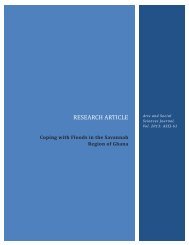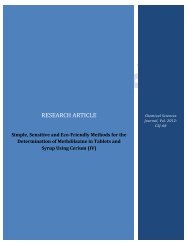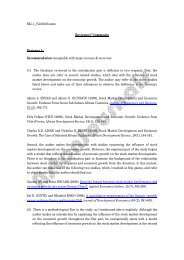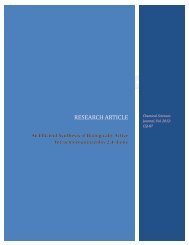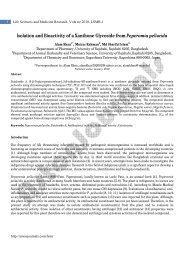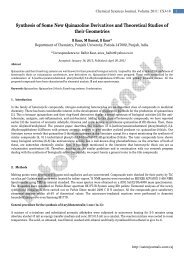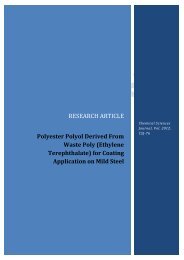(Cyperus esculentus L.) Meal as Dietary ... - AstonJournals
(Cyperus esculentus L.) Meal as Dietary ... - AstonJournals
(Cyperus esculentus L.) Meal as Dietary ... - AstonJournals
Create successful ePaper yourself
Turn your PDF publications into a flip-book with our unique Google optimized e-Paper software.
RESEARCH ARTICLE<br />
Fisheries and<br />
Aquaculture Journal,<br />
Vol. 2013: FAJ-64<br />
Utilization of Tigernut (<strong>Cyperus</strong> <strong>esculentus</strong> L.)<br />
<strong>Meal</strong> <strong>as</strong> <strong>Dietary</strong> Supplement by African Catfish<br />
(Clari<strong>as</strong> gariepinus Burchell, 1822)
Fisheries and Aquaculture Journal, Vol. 2013: FAJ-64<br />
1<br />
Utilization of Tigernut (<strong>Cyperus</strong> <strong>esculentus</strong> L.)<br />
<strong>Meal</strong> <strong>as</strong> <strong>Dietary</strong> Supplement by African Catfish<br />
(Clari<strong>as</strong> gariepinus Burchell, 1822)<br />
Lukman A Agbabiaka 1 *, Chukwuka F Ezeafulukwe 2<br />
1<br />
Department of Animal Science and Fisheries, Imo State University,<br />
Owerri, Nigeria.<br />
2<br />
Department of Fisheries/Marine Technology, Imo State Polytechnic,<br />
Owerri, Nigeria.<br />
*Correspondence: adegokson2@yahoo.com<br />
Accepted: Mar 31 2013; Published: Apr 23 2013<br />
Abstract<br />
Two hundred and fifty five Clari<strong>as</strong> gariepinus fingerlings with average body weight of 5.0 1.0 g were allotted to five<br />
isoproteic diets (CP 5 40%) in which tigernut replaced maize at 0%, 25%, 50%, 75% and 100% respectively. The<br />
catfish fingerlings were divided into five groups of 45 fish per treatment and fed at 3% biom<strong>as</strong>s for 20 weeks. Result<br />
showed significant (p , 0.05) differences in feed intake and specific growth rate but no significant ( p . 0.05) differences in<br />
feed conversion ratio (FCR) and body weight changes among the dietary treatments. This indicates that tigernut meal can<br />
be tolerated <strong>as</strong> replacement for whole maize in African catfish diets without compromising production/yield.<br />
Keywords: Chronic; African catfish; performance; tigernut; biom<strong>as</strong>s.<br />
1. Introduction<br />
The role of fish <strong>as</strong> the cheapest source of animal protein particularly in rural communities of developing<br />
countries h<strong>as</strong> been well documented [1]. The aquaculture industry h<strong>as</strong> been globally recognized <strong>as</strong> the<br />
f<strong>as</strong>test growing food production industry [2] where it contributes more than 19 million metric tons of<br />
fish and shellfish yearly to the world’s fish [3]. In Nigeria, fish contributes 40% of the animal protein<br />
consumption [1, 4].<br />
In spite of this potential, aquaculture in most developing nations including Nigeria is faced with<br />
inadequate supply of quality fish feed at economic price. This problem is worse during the dry se<strong>as</strong>on of<br />
the year when the cost of feedstuffs, most especially cereals, usually soared because the natural demand<br />
for out-weighed the supply. In an attempt to solving this problem of high feed cost, a lot of research efforts<br />
have been geared into alternative novel ingredients in formulating practical diets for farmed fish [5–7].<br />
The primary focus of these researchers w<strong>as</strong> geared towards substituting and/or replacing the<br />
orthodox cereals such <strong>as</strong> maize and millet which often are staple food by Nigerians and major raw-material<br />
in beer- brewing industry. Tigernut (<strong>Cyperus</strong> <strong>esculentus</strong>) is a non-conventional feedstuff that is cultivated<br />
primarily for its oil that is rich in omega 3 fatty acid and the vegetable milk [8]. C. <strong>esculentus</strong> is relatively<br />
cheap compared with maize and the crude protein content ranged between 7% and 9.2% depending on the<br />
variety [8]. Tigernut like other plants h<strong>as</strong> been reported to contain some phytotoxins such <strong>as</strong> alkaloids, trypsin<br />
inhibitors, tannins, phyt<strong>as</strong>e and saponins that are deleterious when fed in high dosage to monog<strong>as</strong>trics [9].<br />
Nevertheless, some of these toxins can be curtailed through processing such <strong>as</strong> fermentation, to<strong>as</strong>ting among<br />
others. This research unlike most other works w<strong>as</strong> designed to evaluate the long-term (chronic) effect of<br />
feeding raw tigernut b<strong>as</strong>ed diets to African catfish on performance using feed intake, body weight changes<br />
and FCR <strong>as</strong> parameters.<br />
<strong>AstonJournals</strong><br />
http://<strong>as</strong>tonjournals.com/faj
2<br />
Research Article<br />
2. Methods<br />
2.1. Source and processing of the ingredient<br />
The tigernuts used for the study were purch<strong>as</strong>ed from the open market at “AMA-HAUSA” in Owerri, Imo State,<br />
Nigeria. The tigernut seed were sundried for 4–5 days and p<strong>as</strong>sed through a hammer mill, to produce tigernut<br />
meal. The drying process w<strong>as</strong> to reduce excess moisture so <strong>as</strong> to prevent rancidity of the material and growth<br />
of moulds.<br />
Other conventional feed ingredients such <strong>as</strong> maize, fish meal, soya bean meal, wheat offal, bone meal,<br />
palm kernel meal (PKM), vitamin-premix and salt were procured from Zion farm feed mills, Egbu, Owerri, Imo<br />
State, Nigeria. A sample of tigernut meal and trial diets were subjected to proximate analysis (Tables 1 and 4)<br />
using standard procedures [10]. The tigernut meal w<strong>as</strong> further subjected to phytochemical analysis for antinutritional<br />
inhibitors using standard methods (Table 2).<br />
Table 1: Proximate composition of tigernut meal (%DM).<br />
Parameters Concentration (%)<br />
Moisture content 7.62<br />
Crude protein 8.44<br />
Ether extracts 27.71<br />
Crude fiber 11.69<br />
Ash 3.51<br />
Nitrogen free extract (NFE) 41.03<br />
Table 2: Anti-nutrients of raw tigernut meal.<br />
Parameters<br />
Quantity<br />
Tannin (%) 1.59<br />
Saponin (%) 1.23<br />
Phyt<strong>as</strong>e (mg/g) 18.12<br />
Phytin phyt<strong>as</strong>e (mg/g) 6.11<br />
Phenols (%) 1.31<br />
2.2. Experimental fish and design<br />
A total of 225 catfish fingerlings (Clari<strong>as</strong> gariepinus) with mean weight 5.0 1.0 g were purch<strong>as</strong>ed from a<br />
commercial hatchery at Owerri, Imo State, Nigeria. They were acclimatized and fed commercial feed for 7 days.<br />
Forty five fingerlings were randomly <strong>as</strong>signed to each of the five isonitrogenous experimental diets in a completely<br />
randomized design. Each treatment group w<strong>as</strong> further divided into 3 replicates of 15 fish in a Hapa net (me<strong>as</strong>uring<br />
1 m 3 1 m 3 1 m) suspended by Bamboo poles in an outdoor cistern (4 m 3 5 m 3 1.2 m). The fish were starved<br />
24 hours prior to commencement of the trial. Water chemistry w<strong>as</strong> usually monitored and maintained [11].<br />
<strong>AstonJournals</strong><br />
2.3. Experimental diets<br />
Five isonitrogenous diets (CP 540%) were formulated such that tigernut meal replaced maize at 0%, 25%,<br />
50%, 75% and 100% respectively. Other feed ingredients were of the same quantities for all the diets. The<br />
feeds so formulated (Table 3) were p<strong>as</strong>sed through pelleting machine with sizes 2 mm and 4 mm for the first 10<br />
weeks and thereafter respectively. Pelletized feeds were sundried until crispy (between 3 and 4 days depending<br />
on the sun intensity). The feeds were fed to the fish at 3% body weight shared into two, between 7–8 am and<br />
4–6 pm daily throughout the duration of the experiment which l<strong>as</strong>ted for 5 months. The feeds were analyzed<br />
for proximate composition [10].<br />
http://<strong>as</strong>tonjournals.com/faj
Fisheries and Aquaculture Journal, Vol. 2013: FAJ-64<br />
3<br />
Table 3: Composition of experimental diets fed to African catfish (C. gariepinus).<br />
Ingredients<br />
Tigernut dietary inclusion (%)<br />
0 25 50 75 100<br />
Maize 25.0 18.75 12.50 6.25 –<br />
Tigernut – 6.25 12.50 18.75 25.0<br />
Soya bean meal 25.0 25.0 25.0 25.0 25.0<br />
Fish meal 20.0 20.0 20.0 20.0 20.0<br />
Groundnut meal 10.0 10.0 10.0 10.0 10.0<br />
Blood meal 10.0 10.0 10.0 10.0 10.0<br />
Spent grain 5.0 5.0 5.0 5.0 5.0<br />
Bone meal 2.0 2.0 2.0 2.0 2.0<br />
Vitamin-premix 0.25 0.25 0.25 0.25 0.25<br />
Lysine 0.25 0.25 0.25 0.25 0.25<br />
Methionine 0.25 0.25 0.25 0.25 0.25<br />
Vegetable oil 2.0 2.0 2.0 2.0 2.0<br />
Salt 0.25 0.25 0.25 0.25 0.25<br />
Total 100.0 100.0 100.0 100.0 100.0<br />
2.4. Data collection<br />
The entire fish in each Hapa were batch weighed at the commencement of the trial and weekly thereafter using<br />
a digital weight balance. Weighed fish were usually returned into their respective Hapa’s thereafter. Feeding<br />
w<strong>as</strong> adjusted weekly according to the new body weight. Stale water w<strong>as</strong> usually drained off the pond <strong>as</strong> and<br />
when required and the pond refilled from the borehole water at the farm complex.<br />
2.5. Statistical evaluation<br />
Data collected were subjected to one way analysis of variance <strong>as</strong> described by Snedecor and Cochran [12] and<br />
where significant difference w<strong>as</strong> indicated such mean w<strong>as</strong> compared using Duncan multiple range test [13].<br />
3. Results<br />
The gross composition of the trial diets is shown in Table 4. Results of the nutrients <strong>as</strong>say of the experimental<br />
feeds revealed that the crude protein concentration decre<strong>as</strong>ed from 40.11% in control diet (0%) to 37.34%<br />
in tigernut b<strong>as</strong>ed diet (100%). Similar trend w<strong>as</strong> observed with soluble carbohydrate NFE concentration which<br />
decre<strong>as</strong>ed with incre<strong>as</strong>ed tigernut inclusion in the diets.<br />
<strong>AstonJournals</strong><br />
Table 4: Proximate composition of tigernut b<strong>as</strong>ed diets fed to catfish (C. gariepinus).<br />
Parameters<br />
Tigernut dietary inclusion (%)<br />
0 25 50 75 100<br />
Moisture content 8.93 9.12 9.76 9.17 9.75<br />
Ash 9.26 8.79 9.78 10.37 10.90<br />
Crude fat 1.48 5.34 5.84 6.54 7.30<br />
Crude fiber 4.28 4.31 4.84 5.52 5.96<br />
Crude protein 40.11 40.06 38.60 38.36 37.34<br />
NFE 35.94 32.38 31.15 30.04 28.75<br />
http://<strong>as</strong>tonjournals.com/faj
4<br />
Research Article<br />
3.1. Feed intake<br />
The mean total feed intake of the trial catfish were 1139.06, 965.90, 1211.02, 934.70 and 938.25 g for<br />
0%, 25%, 50%, 75% and 100% dietary treatments respectively. There were significant differences (p 0.05)<br />
among the treatments. Nevertheless, the correlation between feed intake and body weight gain, FCR and feed<br />
intake for experimental fish were 0.561 and 0.691 (56.1% and 69.1%) respectively implying that there w<strong>as</strong> a<br />
strong positive correlation between feed intake and body weight gain and feed conversion ratio. These correlations<br />
were also statistically significant (p 0.05).<br />
3.2. Body weight changes<br />
There w<strong>as</strong> no significant difference (p 0.05) in body weight gain among the treatment groups. The mean<br />
weight gains of the fish were 284.07, 283.83, 317.54, 288.87 and 259.97 g for 0%, 25%, 50%, 75% and<br />
100% dietary treatments respectively.<br />
3.3. Feed conversion ratio<br />
The FCR of the catfish were 4.01, 3.40, 3.81, 3.23 and 3.61 for 0%, 25%, 50%, 75% and 100% dietary<br />
treatments respectively. The group on 75% dietary inclusion of tigernut had the best FCR while the control diet<br />
recorded the le<strong>as</strong>t value. There w<strong>as</strong> no significant difference (p 0.05) among the treatment groups.<br />
3.4. Specific growth rate<br />
The highest value of 1.24 w<strong>as</strong> recorded from catfish fed 50% tigernut b<strong>as</strong>ed diet while the le<strong>as</strong>t 1.18 w<strong>as</strong><br />
recorded for catfish group fed diet with 100% tigernut inclusion. There were significant differences (p 0.05)<br />
among the treatment groups.<br />
Parameters<br />
Table 5: Performance of C. gariepinus fed tigernut b<strong>as</strong>ed diets.<br />
Tigernut dietary inclusion (%)<br />
0 25 50 75 100<br />
Initial weight of fish (g) 5.93 a 6.17 a 5.96 a 6.03 a 6.03 a<br />
Final weight of fish (g) 290.00 290.00 323.00 295.00 266.00<br />
Weight gain of fish (g) 284.07 a 283.83 a 317.54 a 288.87 a 259.97 a<br />
Total feed intake (g) 1139.06 ab 965.90 bc 1211.02 a 934.70 c 938.25 c<br />
FCR 4.01 a 3.40 a 3.81 a 3.23 a 3.61 a<br />
Specific growth rate (%/day) 1.21 ab 1.19 b 1.24 a 1.21 ab 1.18 b<br />
Protein efficiency ratio 10.24 a 12.00 a 10.41 a 11.93 a 10.06 a<br />
abc<br />
Means within rows with same superscripts are not significantly different (p . 0.05).<br />
4. Discussion<br />
The crude protein of all the diets fall within the recommended range of 35%–40% for African catfish [14–17].<br />
The general incre<strong>as</strong>e in the body weight of the experimental fish in all the treatments is an indication that all the<br />
treatment diets were adequate in dietary protein and other nutrients required by African catfish, similar results<br />
were obtained when tilapia fingerlings were fed on different grains [18], and C. gariepinus fingerlings were fed<br />
cocoyam and tigernut b<strong>as</strong>ed diets [19, 4] respectively.<br />
The greatest body weight gain of fish (317.54 g) recorded at 50% dietary inclusion of tigernut may be<br />
due to synergetic effect between the utilization of polysaccharides in maize and tigernut tubers by the catfish,<br />
and w<strong>as</strong> able to convert it into muscle for growth. Similar reports were obtained when c<strong>as</strong>sava leaves were fed<br />
to tilapia (Oreochromis niloticus) at 66.7% [20, 21]. The best utilization of wild variegated cocoyam in catfish<br />
diet w<strong>as</strong> also recorded at 66% dietary level [22]. This agrees with the literature that channel catfish (Ictalurus<br />
punctatus) utilized polysaccharides for growth better than disaccharides.<br />
<strong>AstonJournals</strong><br />
http://<strong>as</strong>tonjournals.com/faj
Fisheries and Aquaculture Journal, Vol. 2013: FAJ-64<br />
5<br />
The study on boiled cocoyam fed to weaning piglet [23] gave similar growth performance when compared<br />
with the control diet (maize b<strong>as</strong>ed diet) even up to 50%, while another research [24] also reported that<br />
the mixture of rice mill by-products at 50% substitution improves growth of rabbits, better than the control<br />
(maize b<strong>as</strong>ed diet).<br />
Nevertheless, the correlation between feed intake and body weight gain, FCR of experimental fish were<br />
0.561 (56.1%) and 0.691 (69.1%) respectively implied that there w<strong>as</strong> a strong positive correlation between<br />
feed intake, body weight gain and FCR. These may perhaps explain re<strong>as</strong>on for statistically similar specific<br />
growth rate and FCR of the trial catfish (p . 0.05). This result is not in agreement with earlier report [4] that<br />
recorded a decline in growth of African catfish juveniles fed tigernut b<strong>as</strong>ed diets beyond 50% dietary level.<br />
It may also mean that the fish were able to tolerate the tigernut at older age with better physiological<br />
adaptation compared to the juvenile stage when the earlier study w<strong>as</strong> conducted. Similar results have been<br />
reported in poultry which tolerate higher fibre at finisher stage compared to starter ph<strong>as</strong>e [25].<br />
5. Conclusion<br />
Since there were no statistical differences in body weight gain and FCR of African catfish fed tigernut b<strong>as</strong>ed diets<br />
compared to control, and all experimental fish were able to attain the minimum 200 g recommended <strong>as</strong> table<br />
size fish, the test ingredient can safely be recommended <strong>as</strong> a substitute for maize in African catfish diets without<br />
compromising production/yield. However, it will reduce the production cost and cost per kilograms of fish.<br />
Competing Interests<br />
None declared.<br />
Authors’ Contributions<br />
Both authors had read the final draft of the manuscript. LAA designed the experiment, performed the laboratory<br />
and statistical analyses. CFE wrote the protocol and carried out the feeding trial.<br />
References<br />
[1] FAO, 2003. The State of food insecurity in the World (SOFI), Rome, Italy.<br />
[2] FAO, 2000. Projected population and fish demand in Nigeria (1997–2025). FAO Fishery Department Country profile. Nigeria<br />
FID/CP/NIR, Rev. 4th march, Rome, Italy.<br />
[3] Baruah K, Sahu NP, Pal AK, Debnath D, 2004. <strong>Dietary</strong> phyt<strong>as</strong>e: an ideal approach for a cost effective and low-polluting<br />
aquafeed. In: NAGA, World Fish Center Quarterly, 27(3–4): 15–19.<br />
[4] Agbabiaka LA, Madubuiko CU, Anyanwu CN, 2012. Replacement value of tigernut meal (C. <strong>esculentus</strong>) with maize in catfish<br />
(C. gariepinus) diets. Science Research Reporter, 2(2): 130–134.<br />
[5] Eyo AA, 1994. The requirement for formulating standard artificial fish feed. Paper presented at the 11th Annual Conference<br />
of the fisheries society of Nigeria (FISON) held at the Lagos State Auditorium Secretariat Alausa, Ikeja, Lagos State, 22nd–24th<br />
February, p. 15.<br />
[6] Fagbenro AO, Adeparusi E, 2003. Feedstuff and dietary substitution for farmed fish in Nigeria. Paper presented at Pan African<br />
Fish and Fisheries Conference Contonou, Republic of Benin, Book of abstracts, p. 276.<br />
[7] Agbabiaka LA, Madubuike FN, Uzoagba CU, 2012. Performance of catfish (C. gariepinus Burchell, 1822) fed enzyme supplemented<br />
dried rumen digesta. Journal of Agricultural Biotechnology and Sustainable Development, 4(2): 22–26.<br />
[8] Oladele AK, Oshundahunsi FO, Adebowale AY, 2009. Influence of processing techniques on the nutrients and anti-nutrients<br />
of tigernut (C. <strong>esculentus</strong>). World Journal of Dairy and Food Sciences, 4(2): 88–93.<br />
[9] David DL, 2009. Effects of anti-nutritional factors of tigernuts (C. <strong>esculentus</strong> L.) and soybeans (Glycine max L.) on growing<br />
rabbits. Bioscience Research Communications, 21(5): 241–247.<br />
[10] AOAC, 2000. Official Methods of Analysis. Association of Official Analytical Chemists (Ed. Herrick K), 17th Edition. W<strong>as</strong>hington,<br />
DC, USA.<br />
<strong>AstonJournals</strong><br />
http://<strong>as</strong>tonjournals.com/faj
6<br />
Research Article<br />
[11] Boyd CE, 1979. Water Quality in Warm Water Fish Ponds. Agriculture Experiment Station, Auburn University, Alabama,<br />
p. 359.<br />
[12] Snedecor GW, Cochran WG, 1967. Statistical Methods, 6th Edition. Ames, Iowa, USA: Iowa State University Press.<br />
[13] Obi IU, 1990. Statistical Methods of Detecting Difference Between Treatment Means, 2nd Edition. Enugu. Nigeria: Snaap<br />
Press.<br />
[14] Faturoti EO, Balogun AM, Ugwu LLC, 1986. Nutrient utilization and growth responses of C. lazera fed different dietary protein<br />
levels. Nigerian Journal of Applied Fisheries and Hydrobiology, 1: 41–43.<br />
[15] Eyo AA, 1990. Some <strong>as</strong>pect of utilization of soybean meal by young mudfish (Clari<strong>as</strong> anguillaris L.), Ph.D. thesis, Ahmadu<br />
Bello University, Zaria, Nigeria.<br />
[16] Fagbenro OA, 1992. Utilization of cocoa pod husk in low-cost diets by the clariid catfish (Clari<strong>as</strong> isheriensis Sydenham).<br />
Aquaculture and Fisheries Management, 23: 175–182.<br />
[17] Agbabiaka LA, 2010. Evaluation of some under-utilized protein feedstuffs in diets of C. gariepinus fingerlings. International<br />
Journal of Tropical Agriculture and Food systems, 4(1): 10–12.<br />
[18] Solomon SG, Tiamiyu LO, Agaba UJ, 2007. Effect of feeding different grain sources on the growth performance and body<br />
composition of tilapia (O. niloticus) fingerlings fed in outdoor hap<strong>as</strong>. Pakistan Journal of Nutrition 6(3): 271–275.<br />
[19] Aderolu AZ, Sogbesan OA, 2010. Evaluation and potential of cocoyam <strong>as</strong> carbohydrate source in catfish (C. gariepinus<br />
Burchell, 1822) juvenile diets. African Journal of Agricultural Research, 5(6): 453–457.<br />
[20] Bichi AH, Ahmad MK, 2010. Growth performance and nutrient utilization of African catfish (C. gariepinus) fed varying dietary<br />
levels of processed c<strong>as</strong>sava leaves. Bayero Journal of Pure and Applied Sciences, 3(1): 118–122.<br />
[21] Faturoti EO, Akinbote RE, 1986. Growth responses and nutrient utilization in O. niloticus fed varying levels of dietary c<strong>as</strong>sava<br />
peel. Nigerian Journal of Applied Fisheries and Hydrobiology, 1: 47–50.<br />
[22] Agbabiaka LA, Odoemenam SA, Esonu BO, 2006. Preliminary investigation on the potentials of wild variegated cocoyam<br />
(Caladium hortulanum) replacement for maize in diets of catfish (Heterobranchus bidorsalis) fingerlings. International<br />
Journal of Agriculture and Rural Development, 7(1): 138–142.<br />
[23] Agwunobi LN, Angwukam PO, Cora OO, Isiaka MA, 2002. Studies on the use of Coloc<strong>as</strong>ia esculenta (Taro cocoyam) in the diet<br />
of weaned pigs. Tropical Animal Health Production, 34(3): 241–247.<br />
[24] Esonu BO, 1997. Substitution value of a mixture of rice millings by-product for maize in diets of weaner rabbits. Bulletin of<br />
Animal Health and Production in Africa, 45: 67–69.<br />
[25] Esonu BO, Ogbonna UD, Anyanwu GA, Emenalom OO, Uchegbu MC, Etuk EB, et al., 2006. Evaluation of performance, organ<br />
characteristics and economic analysis of broiler fed dried rumen digester. International Journal of Poultry Science, 5(2):<br />
1116–1118.<br />
<strong>AstonJournals</strong><br />
http://<strong>as</strong>tonjournals.com/faj



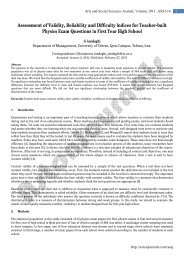
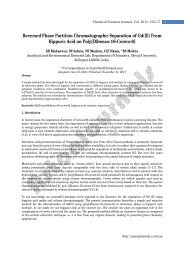
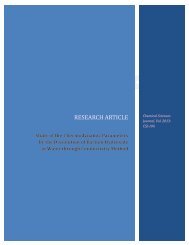
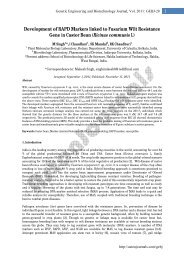

![[1,4]-benzodiazepine-2-one Derivatives as Potent - AstonJournals](https://img.yumpu.com/49117784/1/184x260/14-benzodiazepine-2-one-derivatives-as-potent-astonjournals.jpg?quality=85)
